Content
- 1 Honey variety
- 2 Dessert variety
- 3 Variety Summer Duchess
- 4 Variety Tavricheskaya
- 5 Early varieties of summer pears for the middle lane: photo and description
- 6 What are the best winter-hardy pear varieties?
- 7 Photo and description of pear varieties of autumn ripening period
- 8 The most delicious varieties of autumn pears for the middle lane
- 9 The best varieties of winter pears: photo and description
- 10 Pear tree varieties
- 11 The best varieties of pears
- 12 What varieties of pears are new
- 13 Basic requirements for pear varieties for Central Russia
- 14 Early (summer) varieties
- 15 Autumn varieties
- 16 Winter (late) varieties
- 17 The sweetest varieties

Pear is a fruit tree, quite durable (some varieties have been growing for 200 years). In terms of popularity and its massiveness, it is second only to apple trees. It blooms with white and pink flowers.
Most of the pear varieties are self-fertile, in other words, trees cannot pollinate on their own, they need trees of other varieties and pollinating insects for this.
It is for this reason that it is always necessary to plant a tree with a different type of fruit or a different variety next to pears. The plant is very light-requiring.
Ripe fruits can be very large - 300 gr., And very small - about 25 gr., Color from green to yellow, with or without blush. Many varieties of pears bring a large harvest every two years, and only from the age of seven.
In order for the harvest to be good, it is necessary to plant different varieties and at some distance from each other. To choose the best options for seedlings, you need to know their varietal characteristics. There are autumn, summer and winter varieties of pears, depending on the time of fruiting.
We will consider the most delicious and popular varieties among gardeners in this article.
Honey variety
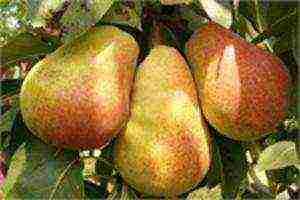
Pear variety Honey
The tree grows only in warm areas. It grows small and compact, thanks to this size, you can save space in the garden, and plant a few more trees of other varieties.
Despite the fact that the tree is a small crop, it brings abundant, and begins to give birth early already in the third or fifth year after planting. Considered partially self-fertile.
By the time of harvesting - the fruits ripen in late autumn. The fruits are harvested around the end of September, and the harvest period coincides with the period of consumption.
The fruits keep very well, and you can transport them without worrying that they will be damaged. Honey pear is resistant to various fungal diseases and winter hardy.
Ripe fruits:
- large, in weight reach from 300 to 500 grams;
- unequal in shape, surface with tubercles;
- the skin is thin and dry;
- the color is greenish-yellow;
- the surface is covered with small dots that look like rust;
- the pulp is oily, insanely juicy, pears are very aromatic;
- the taste is sweet and tender.
This variety is perfect for the most demanding housewives. Such fragrant and tasty pears are rarely found even in a good store. At the same time, the variety is not demanding on growing conditions and place of growth.
Advice to hostesses: pear variety Honey is perfect for making various desserts, compotes, jams and preserves.
It will remain in the refrigerator until winter, and in the New Year it will look great at the festive table.
Dessert variety
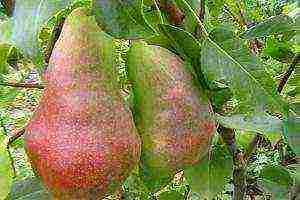
Dessert pear variety
This pear ripens in autumn. It is not too early to bloom, and not too late. The variety is winter-hardy and does not suffer from fungal diseases.
The first bountiful harvest ripens in the fourth year. The average yield is about 70 kg per tree.
The weight of the fruits is on average 160-220 grams, the shape resembles apples, the color is yellow-green, and at the time of consumption is light gold.
The dessert pear is strewn with small blotches of green and brown. This variety has excellent taste characteristics:
- juicy;
- sweet;
- pulp color - cream;
- melting;
- no graininess (no sandy taste).
The variety is very transportable and has a good yield.
Variety Summer Duchess
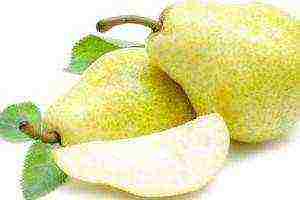
Pear variety Duchess
This is probably one of the best known and best pear varieties. In fact, it has many advantages over other varieties, both flavoring and growing.
The tree is medium-sized, with a dense and branched crown. Very beautiful inflorescences, bloom for a long time, which makes this tree a decorative decoration of the garden. The variety is self-fertile.
Unfortunately, it is not very frost-resistant. The first crop brings in six years after planting the seedling, but the harvest is abundant. The fruits have a great description:
- the color of the fruit is light green, at the time of consumption it is bright yellow, sometimes even orange;
- the taste is delicate, juicy and sweet;
- the flesh is white or creamy, soft;
- thin skin;
- the aroma of the Duchess fruit has a specific bouquet inherent in nutmeg;
- oblong fruits in shape;
- weight reaches 200 grams.
Take a note: Duchess pears make excellent light wine and delicious marmalade.
This is one of the earliest pears. The only drawback is that the fruits are not stored for long, only about two and a half weeks.
Variety Tavricheskaya
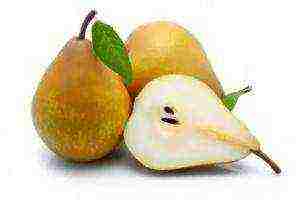
Pear variety Tavricheskaya
The flowering period is medium-late, the ripening period is winter-late (they are removed in September, the fruits must be consumed in February). The variety also needs pollinators.
The pear is unpretentious to the soil. After four years, you can harvest. The fruits are very large from 250 to 300 grams, sometimes reaching a maximum of 600 grams.
Tavricheskaya pear is very tasty, juicy, sweet with a slight sourness, the flesh is creamy in color. Fruits are yellow in color, with a slightly rough surface and small, barely noticeable brown dots.
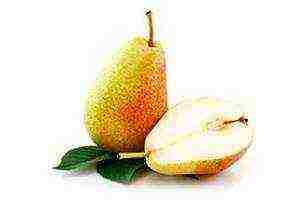
Perhaps you will be interested in the article about
pear variety Lada
.
You can read about the unusual fruit of Pepino's melon pear
here
.
All varieties are very good in terms of taste, maturity and description. Each variety has its pluses and minuses, while some minuses are difficult to name them.
Many varieties bring a crop only once every two years, but at the same time they still bloom, thereby helping to pollinate neighboring trees, and their color is very beautiful - they carry the function of decoration in the garden.
Advice for gardeners: The most correct solution is to plant several varieties of pears with different ripening periods, so that sweet and juicy pears are on your table during all warm months.
Watch the following video about one of the autumn pear varieties - Noyabrskaya:
Rate the article
(
estimates, average:
out of 5)
The best varieties of pears in the video.
The most significant contribution to the development of new varieties of pears of Russian selection was made by the famous biologist and botanist, director of the first genetic selection station IV Michurin. It was thanks to his many years of painstaking work that such delicious pear varieties as Sugar Surrogate, Bere Zimnaya, Tolstobezhka and many others, adapted for the average Russian climatic conditions, were obtained.
After IV Michurin, little was involved in the selection of pear varieties for central Russia and other regions, since gardeners were frightened by the length of the process: pear seedlings often begin to bear fruit in the 12th and even 30th year after sowing.And at the experimental stations, breeders gave preference to the apple tree. Nevertheless, to date, especially over the past 30 years, new promising pear varieties have been created.
This page contains photos, names and descriptions of the best pear varieties for Russian regions.
Early varieties of summer pears for the middle lane: photo and description
August dew.
The summer variety was obtained by S.P. Yakovlev at the All-Russian Research Institute of Genetics and Breeding of Fruit Plants. IV Michurin from crossing a donor of high winter hardiness and a source of complex disease resistance (variety Tenderness x Australian variety Triumph Pakgama). It is becoming more widespread due to a complex of valuable economic and biological characteristics.
The tree is small, fast-growing, with a slightly drooping, medium-dense crown. Differs in high kidney awakening and shoot-forming ability. The bark on the trunk and skeletal branches is smooth, gray. Branches branch off almost at right angles. The predominant type of fruit formations is ringlet, spear.
Shoots are thick, geniculate, curved, light brown, many lentils, small. The kidneys are bent, conical, medium. The leaves are medium, oblong - ovate, short-pointed, dark green, shiny, the base is wedge-shaped, the blade is directed upward, the edge is serrate. The petiole is of medium length and thickness, the internodes are medium. Stipules are saber-shaped, small.
As you can see in the photo, the fruits of this pear variety are of medium size, rather one-dimensional, short-pear-shaped, without ribs:
Coloring at the moment of ripening: the main green, the integumentary is absent, During the period of consumer maturity, the main is greenish-yellow, the integumentary is very weak blush on the smaller part of the fruit, there are many subcutaneous dots. The skin is smooth and dull. The peduncle is long, thick, curved. The funnel is shallow, blunt-conical. The cup is small, closed. The saucer is small, wide, slightly ribbed. The heart is large, bulbous. Closed cameras, medium. The subcapillary tube is short, wide, cupped. There is a slight rustiness at the funnel. The pulp is white, fine-grained, juicy, sour-sweet taste, tender. The fruits stick firmly to the tree and ripen in mid-August, the period of consumption and storage is up to two weeks. The marketability of fruits is high. The fruits are mainly for table purposes.
This summer pear has a low self-fertility rate. The best pollinator - In memory of Yakovlev. However, it gives a good harvest when pollinated with the Lada variety. Trees begin to bear fruit 4 years after planting in the garden, fruiting is annual. Winter hardiness is high. Fruits and leaves are not affected by scab. Advantages of the variety: early maturity, high winter hardiness, yield, marketability of fruits, resistance to the most common fungal diseases.
The disadvantage of this variety of pears of early ripening is that with a bountiful harvest, there is some unevenness in the fruit.
Academic.
A new promising variety of late summer or early autumn ripening. Bred at the Moscow Agricultural Academy (MCAA). The tree has a spreading crown and a restrained growth force.
Pay attention to the photo - in this summer pear variety, fruits weighing up to 150 g have a cover color in the form of bright carmine stripes of various thicknesses:
The pulp of medium density, dessert taste, after storage acquires a well-perceptible aroma and caramel flavor.
Bashkir large.
A variety of late summer or early autumn ripening. Trees of medium size and medium density, wide pyramidal shape. Shoots are thick, geniculate, reddish-brown. Leaves are broad-ovate, long-pointed, dark green with a bluish tinge. The leaf blade is curved downward and slightly folded along the central vein. The edge of the leaf is almost smooth, wavy. The petiole is reddish brown.
The name of this variety of pears is given for the size of the fruits - they are large (130-150 g), one-dimensional, wide-round, regular in shape, green-yellow. The pulp is white, tender, fine-grained, of medium density and juiciness, good taste.
These photos show the summer varieties of pears, the description of which is given above:
Full characteristics of summer varieties of pears: photos, names and descriptions
Bashkir summer.
The variety is winter-hardy, fruitful. Crown of medium size and medium thickening, wide pyramidal, fruiting mainly on lances and bouquet branches. Leaves are medium in size, elongated-oval, with a short-pointed apex. The leaf blade is curved downward, the petiole is long and thick. Flower buds are large, lunar.
This is one of the earliest varieties of pears with medium-sized fruits (70-80 g), oval-pear-shaped. The peduncle is of medium length and thickness. The skin is of medium thickness, smooth, dull, oily. The main color of the fruit is greenish-yellow, the integumentary color is in the form of a light tan on the sunny side. The pulp is white, fine-grained, juicy, of medium density, good sweet and sour taste, aromatic.
Seedless.
The most common summer variety of folk selection.
The tree grows relatively quickly, becoming tall with a broad-pyramidal crown of medium density. It is distinguished by its great endurance even in the conditions of the Middle Trans-Volga region, but in very severe winters it freezes underneath, quickly recovering.
Look at the photo - this early pear variety has medium-sized fruits, short pear-shaped:
Ripen in late August - early September. They keep on the tree for about a month. In case of incomplete maturation, transportation is well tolerated. The skin is green during removal; when ripe, which occurs quickly, it becomes light yellow with a cloudy dark orange blush. The pulp is light yellow, very juicy, almost melting, sweet, with some spice. The fruits are mainly used fresh; only unripe are suitable for processing. The yield is high. The variety is self-fertile, produces many fruits without seeds. The variety is resistant to diseases and pests.
Prominent (Bumpy).
Late-summer variety of selection VSTISP, obtained from pollination of interspecific hybrid VI -53-67 with a mixture of southern varieties of pollen. Authors Yu. A. Petrov, N. V. Efimova. This pear variety is suitable for the Moscow region, it is also zoned for the Central region.
The full characteristic of the pear variety Vidnaya (Bumpy) is as follows. A tree at a young age with a spreading, then pyramidal, medium-dense crown formed by powerful branches with rather large numerous ringlets, on which fruiting is mainly concentrated.
Shoots are long, of medium thickness, light brown. Leaves are medium, smooth, with raised serrated edges. Petioles of medium length and thickness with lanceolate stipules.
Fruits are of medium and above average size, elongated pear-shaped, symmetrical, with a ribbed uneven surface. The main color is greenish-yellow, the integumentary color is in the form of a light orange tan. The peduncle is of medium length and thickness, curved. The calyx is medium, closed over a short funnel-shaped sub-mucosa tube. The seed chambers are closed, with medium, elongated, brown seeds. The axial cavity is medium. This is one of the most delicious varieties of pears for the middle lane with a white, very juicy, sweet and sour pulp of excellent taste. Ripening is non-simultaneous, it is better to collect it in 2-3 doses. Ripe fruits are better preserved on the tree, after removal they are not stored for a long time. The fruits are good for fresh consumption and for processing. The beginning of fruiting at 4-5 years (from the year of growth in the nursery). Winter hardiness of trees is high, at the level of old average Russian varieties. The variety is resistant to fungal diseases.
Here are photos of varieties of early pears, the description of which is given on this page:
Children's. This variety got this name because children especially like to feast on its sweet fruits.The tree is powerful, durable. Winter hardiness at the Antonovka level.
Fruits are medium-sized (60-70 g), bright yellow with an orange blush. Ripen 10 days earlier than Papirovka, which usually opens the apple season.
Yellow-fruited. The variety was bred in YUNIIPOK. The tree is medium-sized, spreading, with a rounded crown, medium-hardy, fruitful.
Fruits weighing 110 g, large - up to 150 g, pear-shaped, yellowish-green, with a blush on the lighted side, ripen at the end of August and are stored for two weeks. The pulp is white, juicy, sweet. Pollinating varieties: Rainbow, Severyanka, Fabulous.
The main characteristic of this pear variety is its high resistance to pear gall mite and fire blight; it is not affected by scab.
Space. The variety was bred at the All-Russian Research Institute of Horticulture (Michurinsk). The variety is medium-hardy, medium-yielding. When describing this pear variety, it is worth noting that it is slightly affected by scab. It begins to bear fruit in the 7-8th year after planting. The trees are vigorous with a rounded-spreading or wide-pyramidal crown.
Fruits of medium size (70-100 g), cuboid, yellow, with a slight blurred blush. The pulp is sweet, fine-grained, of pleasant taste, for table use. The fruits ripen in the second half of August; they remain in maturation for 2 weeks.
Lada. Variety of selection of the Moscow Agricultural Academy named after KA Timiryazeva, moderately hardy, productive, relatively resistant to scab, begins to bear fruit in the 4-5th year after planting.
This is one of the best pears for the Moscow region with medium-sized fruits (110-150 g), pear-shaped, yellow. Ripen in the second half of August. Stored for up to two weeks. The pulp is semi-oily, sweet and sour taste, for table use.
Moscow. The variety was bred by VSTISP (Moscow). Medium-hardy, medium-yielding, medium-resistant to scab. The trees are medium-sized with a wide-pyramidal crown; they begin to bear fruit in the 6-7th year after planting.
Fruits are of medium size (70-100 g), pear-shaped, obovate, golden yellow. The pulp is juicy, sour-sweet, of good taste, buttery, for table use. The fruits ripen in late August-early September; they remain in maturation for about two weeks.
Look at the photos of pear varieties, the description of which is presented in this section:
Fabulous. The variety was bred in YUNIIPOK. The tree is medium-hardy, medium-sized, with a tight crown.
This is one of the best pear varieties with large, beautiful fruits with a good dessert taste, ripens at the end of summer and is stored for two weeks. The pulp is juicy, sweet. The variety is resistant to pear and gall mites and bacterial burns, and is not affected by scab.
Below you will find out which winter hardy pear varieties are the best.
What are the best winter-hardy pear varieties?
Krasulia. The variety was bred in YUNIIPOK. The tree is medium-sized, with a rounded dense crown. This is one of the most winter-hardy varieties of pears, fast-growing (4-5th year), medium-yielding.
Fruits weighing 90 g, large - up to 110 g, irregular, oval-flattened, yellow-green, with a dark red blush. Ripen in the first half of August, 7 days earlier than Severyanka and stored for 10-12 days.
The pulp of the fruit is creamy, friable, fine-grained, very juicy, of good taste with spice.
Rainbow. The variety was bred in YUNIIPOK. The tree is medium-sized, with a tight, rounded crown, highly winter-resistant, early-growing (4-5th year). Pollinating varieties Krasulia, Severyanka, Fabulous.
The fruits of this pear variety, recommended for the middle lane, are round or short pear-shaped, with an average weight of 110 g, with a slight tan on the sunny side. The pulp is white, juicy, sweet. They taste like southern pears.
The variety is not affected by pear gall mites and scab, it is resistant to fire blight.
Rogneda. A promising variety of late summer ripening. Brought to the Moscow Agricultural Academy.
Fruits weighing up to 120 g, an unusual flattened-rounded shape for a pear. The pulp is very juicy, oily, melting in the mouth, excellent taste without the slightest acidity and astringency.In the period of full fruiting, the yield from a medium-sized tree reaches 70-80 kg.
These photos show varieties of pears, with the names and characteristics of which you familiarized yourself with above:
Ruddy Kedrina. The variety was bred at the Samara experimental gardening station by crossing Volozhka with Favorite Klappa. Winter hardy and fruitful. The trees are vigorous with a pyramidal crown, begin to bear fruit in the 6-7th year after planting.
The fruits ripen in the second half of August. They are medium-sized and large, pear-shaped, greenish-yellow with a red blush. The pulp is whitish, oily, good sweet and sour taste, for table use.
Severyanka. The variety is fast-growing, productive, winter-hardy. The trees are medium-sized with a wide-pyramidal crown, begin to bear fruit in the 4th-5th year after planting. The variety is resistant to pear gall mite, fire blight and scab.
The fruits ripen in the second half of August and are stored for up to two weeks. O
Pay attention to the photo - this variety of pears, recommended for the Moscow region, have small or medium-sized fruits (50-80 g), conical, greenish-yellow, with a slight blush on the sunny side:
The pulp is juicy, dense, good sweet and sour taste.
Rival. The tree is winter-hardy, early-growing, medium-sized and very productive, as a result of which the fruits can shrink from 120-140 g (the norm of this variety) to 80-90 g.
The fruits of this early pear variety, grown in the middle lane, are elongated pear-shaped, yellowish-green, turn yellow when overripe. Ripen a little earlier than Lada. With timely removal, they are stored for 2-3 weeks.
Summer Tenkovskaya. The variety was obtained by G.I. Rozanova from crossing a semi-cultivated pear with Volga Bergamot. The tree is vigorous, with a wide-pyramidal crown, well leafy. Annual shoots are purple with large, compressed buds. The leaves are dark green, ovate, folded in a boat, with long purple petioles.
The fruits are large (up to 150-180 g), rounded, similar in shape to Begramot Volga, but more elegantly colored and better in taste.
Thin line. A widespread variety of folk selection. The tree is vigorous with a wide-pyramidal crown.
Fruits are regular pear-shaped, medium-sized, on rather long petioles. They hold firmly on the tree. The skin is yellow-green with a brown blush. The pulp is white, of medium density, quite juicy, sweet and sour taste with a slight astringency. Fruits ripen in August-September. They can be eaten fresh, dried. When describing this variety of pears grown in the middle lane, it is worth noting their very poor keeping quality, therefore, freshly ripe fruits must be used for processing.
Below are photos, names and descriptions of autumn pear varieties.
Photo and description of pear varieties of autumn ripening period
Bashkir autumn. The variety is distinguished for its high winter hardiness and good yield. The crown is wide-pyramidal. The bark on the trunk and main skeletal branches is dark red. Leaves are medium in size, wide, elliptical, short-pointed, shiny. The leaf edge is finely serrated or solid.
The fruits of this variety of pears have an autumn ripening period of medium size, one-dimensional, elongated pear-shaped. Ripen in September. The main color is yellow-green, the integumentary color is brownish-red. The pulp is of medium density, fine-grained, juicy, sweet and sour taste.
Burakovka. Autumn variety of folk selection for the winter period of consumption. Named for the similarity of the color of the pulp with beets, which in the south is called beetroot. The pulp is very dense, medium juiciness, sweetish in taste. When describing this autumn pear variety, it should be noted that there is absolutely no acid in their fruits.
The fruits are large, capable of being stored in the cellar until March, and sometimes even more.
Veles (Excellent Daughter). Autumn variety of VSTISP selection, obtained from the crossing of Venus with the Forest Beauty. Authors: Yu. A. Petrov, N. V. Efimova.Distributed in private gardens in Moscow and neighboring regions. Included in the State Register (zoned) in 2001. Beginning of fruiting in the 5-7th year (from the year of growth in the nursery). The yields are plentiful and regular. Winter hardiness of trees is high, at the level of old Central Russian varieties. The variety is resistant to fungal diseases.
A tree at a young age with a spreading, then wide-pyramidal crown formed by curved branches with rather large, evenly spaced annelids, on which fruiting is mainly concentrated.
As you can see in the photo, the fruits of this variety of autumn pears are of medium and above average size, wide pear-shaped, symmetrical, without ribs:
The surface is smooth. The main color is greenish-yellow, the integumentary color is in the form of a light orange tan. The peduncle is of medium thickness, long, curved. The pulp is creamy, medium density, semi-oily, tender, juicy, sour-sweet, excellent taste.
Fruit ripening is simultaneous, but the collection is best done in two steps, starting with the largest. The fruits are good for fresh consumption and are kept in the refrigerator until mid-November.
Faithful. Autumn variety of VSTISP selection. Authors Yu. A. Petrov, N. V. Efimova. Winter hardy. Fast-growing. In the conditions of Moscow, the fruits ripen from mid-September to early October. When describing this variety of pears recommended for the Moscow region, it is important to note their high keeping quality - the fruits can be stored in the refrigerator until early December.
The tree is medium-sized with a drooping, irregular crown of medium density. The predominant type of fruit formation is simple and complex ringlets, spears, spurs, fruit bags.
Fruits are of medium size (100-140 g), pear-shaped, slightly beveled. The main color at the time of removable maturity is green, the integumentary color is in the form of a light tan on the smaller part of the fruit. The main color at the time of consumer maturity is greenish-yellow. There are few subcutaneous points. The pulp is creamy, medium density, tender, semi-oily, fine-grained, very juicy, sweet and sour taste (4.5 points), with a weak aroma.
Cheerful. The variety was bred in YUNIIPOK (Chelyabinsk). The tree is medium-sized, with a wide-spreading rounded crown, winter-hardy, medium-yielding.
Pay attention to the photo - the fruits of this variety of pears grown in the middle lane, with an average weight of 76-99 g (large - up to 130 g), short pear-shaped, green, yellow-green when ripe, with a blurred light red color with strokes in half fetus:
The pulp is juicy, tender, white. Taste score 3.7-4.5 points. The fruits ripen in the first half of September and are stored for a month.
In memory of Yakovlev. The variety was obtained at the V.I. IV Michurin and Michurinsky Agricultural University. Authors P. N. Yakovlev, S. P. Yakovlev, Ya. S. Nesterov, I. M. Korshinova. Early autumn consumption period. Winter hardiness is above average. Scab resistant. The yield is high, annual. Fast-growing.
The tree is short, fast-growing, of medium density, with a rounded crown. The main branches branch off at an angle close to a straight line; with age, numerous branched ringlets are formed. The bark on the trunk and main branches is gray, scaly. Differs in high kidney awakening and shoot-forming ability. The predominant type of fruit formations is simple and complex ringlets.
Shoots of medium thickness, light brown, geniculate, often with spines, few lentils. The kidneys are bent, conical, smooth, with a very large subrenal cushion. Leaves are of medium size, obovate, green, leathery, the top is twisted, the blade is slightly curved. The edge is serrate, the petiole is long, the stipules are medium, lanceolate.
The flowers are white, in inflorescences 4-6, saucer-shaped, separate petals, no terry.
Fruits are medium in size (125 g), with abundant fruiting, unevenness is observed, wide pear-shaped, slightly ribbed surface is smooth. The skin is shiny.At the moment of ripening, the main color is light yellow, the integumentary color is in the form of a slight tan on the smaller part of the fruit. In the period of consumer maturity, the main color is golden-yellow, the integumentary orange is on the smaller part of the fruit, there are few subcutaneous points. The peduncle is long, curved, of medium thickness. The funnel is small, medium, the calyx is half-open. The saucer is small, narrow, slightly ribbed. The heart is medium, the chambers are closed, medium, the subacheal tube is medium, cauliflower. The pulp is creamy, juicy, sweet, with a pleasant aroma, semi-oily, without astringency, with small granulations at the seed nest.
The fruits of this one of the best varieties of pears for the middle zone of universal use, give high-quality processed products - jam, compote. They stick firmly to the tree and are well transported.
Trees begin to bear fruit 3-4 years after planting in the garden. The yield is growing rapidly. Seven-year-old plants yielded more than 20 kg per tree. The small size of the trees allows for more compact plantings.
Look at the photo of the autumn varieties of pears, with the description of which you have read above:
Below are photos and descriptions of pear varieties for the Moscow region and other regions of the middle lane.
The most delicious varieties of autumn pears for the middle lane
Long-awaited. Variety of autumn ripening, bred in YUNII-POK. The tree is medium-sized, broadly spreading, highly winter-resistant.
Fruits are irregular, with an average weight of 70 g, oval lemon-shaped, green, with color on the sunny side. The pulp is white, juicy, sweet and sour (4.2 points).
The variety is resistant to bacterial burns, scab, slightly affected by pear gall mites.
Daughter of Blankova (Seedling of Blankova). The variety is fruitful, moderately hardy, not very whimsical to soil conditions. The tree is above average with a narrow pyramidal crown. Begins fruiting in the 7-8th year. It blooms in the third decade of May - the second decade of June.
As you can see in the photo, the fruits of this pear variety grown in central Russia are of medium size, short pear-shaped or blunt-conical in shape:
The skin is green at first, slightly yellow when ripe. The pulp is white, juicy, sweet, becomes starchy when overripe. Fruits ripen in the first half of September, and remain in maturation for up to 10-18 days.
In wet years, the fruits are affected by scab.
Golden ball. It begins to bear fruit in the 4-5th year after planting by a one-year-old. Fruiting was noted on annual shoots. The tree is medium-sized, with a rounded crown, highly winter-resistant, fruitful (25 kg per tree).
Fruits are short-pear-shaped, one-dimensional, weighing 110 g, green, with a slight tan on the lighted side. Ripen in September. This is one of the most delicious varieties of pears, the pulp of which is juicy, fine-grained, sweet.
Red-sided. The variety was bred in YUNIIPOK. The tree is weak, with a rounded crown, compact, does not thicken, highly winter-resistant, medium-ripening (5-6th year). Pollinator varieties - Myth, Poislaya.
The fruits are very beautiful, pear-shaped, large (140 g), with color on the illuminated side. The pulp is white, juicy, sweet and sour.
This one of the best pear varieties is resistant to pear gall mites and scab.
Larinskaya Variety bred at YUNIIPOK. The tree is medium-sized, with a rounded crown, winter-hardy. Pollinating varieties - Yellow-fruited, Poislaya, Fabulous.
Fruits are pear-shaped, weighing 110 g, large - up to 180 g, pure green, not colored. Ripen in mid-September and stored for a month. The pulp of the fruit is white, juicy, sweet and sour.
Lemon. A productive, disease-resistant variety of folk selection. The tree is vigorous, winter-hardy (not inferior to the Thin branch).
Fruits are small, yellowish-green, of mediocre taste. Ripen in the first half of September. They are stored for up to 12-15 days in prone.
Favorite of Yakovlev. Autumn, medium-hardy variety. Bred at the All-Russian Research Institute of Genetics and Selection of Fruit Plants. Widely distributed in central Russia.Begins to bear fruit in the 6-8th year after planting.
The trees are vigorous with a wide-pyramidal crown. Skeletal branches are thin, depart from the trunk at a large angle, hang down by the weight of the crop. Weak branching. The crop is formed mainly on bouquet branches, less on spears and annual shoots. The leaves are small, oval-pointed, their edges are finely toothed. The petiole is long, thin, with large lanceolate stipules.
Look at the photo - this one of the best varieties of pears has large fruits (up to 130-200 g), double-conical in shape:
The color when removed is greenish-yellow, when ripe it becomes bright yellow with a blurred orange blush on the sunny side. The pulp is yellowish, fine-grained, juicy, sweet-sour with a specific taste. The peduncle is long, thin, slightly curved, with a flow at the base. For processing, the fruits begin to be harvested in mid-September, although full ripeness occurs only at the end of this month. They can lie until the end of October.
Myth. The variety was bred at YUNIIPOK. The tree is tall with a pyramidal crown, highly winter-resistant. The variety is distinguished by the increased resistance of flowers to spring frosts. Resistant to pear gall mite, scab and fire blight.
Fruits with an average weight of 55 g, round or short pear-shaped, ripen in the second half of September and are stored until December 10-15, acquiring a yellow color without a blush. The pulp is white, juicy, sweet.
Marble. One of the best varieties of early autumn ripening for the regions of the Central Black Earth Region. Bred at the Rossosh zonal experimental selection station.
Fruits are medium or above average in size, with almost no acid in their taste. The fruits will be especially charmed by the warm pink cover color, reminiscent of marble.
Elegant Efimova. The variety is medium-yielding, moderately winter-resistant, moderately drought-resistant, slightly affected by scab. The trees are medium-sized with a pyramidal crown; they begin to bear fruit in the 6-7th year after planting.
Fruits ripen at the beginning of September; they remain in maturation for up to two weeks. They are medium and small (60-120 g), elongated pear-shaped, greenish-yellow, with a blurred dark red blush. The pulp is white, medium juicy, sour-sweet, slightly tart, for table use.
Otradnenskaya. A variety of autumn ripening period. Brought to the Moscow Agricultural Academy.
Fruits of medium size (120-140 g) and good taste, can be stored for up to 160 days in plastic bags in the refrigerator. This one of the best pear varieties for central Russia has a high winter hardiness. Virtually not damaged by scab. With a weak growth force, the yield from one tree is quite high - up to 60 kg.
Dangling. The variety was bred at YUNIIPOK. The tree is highly winter-resistant, medium-sized, spreading, with a rounded crown. Begins to bear fruit in the 4th year.
The fruits ripen in the second decade of September and can be stored for up to a month. The pulp is white, juicy, sweet and sour. The variety is resistant to fire blight and scab, slightly affected by the pear gall mite.
Chizhovskaya. The variety is moderately hardy, productive, medium resistant to scab. Brought to the Moscow Agricultural Academy. K. A. Timiryazeva. The trees are medium-sized with a wide-pyramidal crown, begin to bear fruit in the 5-6th year after planting.
The fruits ripen in early September and last up to 3-4 weeks. They are medium (120-140 g), oblong-pear-shaped, greenish-yellow. The pulp is juicy, semi-oily, of good sour-sweet taste, for table use.
In the last section of the article, you can find photos and descriptions of winter pear varieties.
The best varieties of winter pears: photo and description
Bere winter Michurina. The most winter-hardy of the introduced winter varieties.
The tree is medium-sized, with a rounded or oval-rounded crown.
Medium resistant to diseases and pests. Shoots of medium thickness, brown. Leaves of medium size, green with a waxy bloom, stay on trees until frost.
Pay attention to the photo - this winter pear variety has large, wide pear-shaped fruits, often uneven:
Hang on a tree for a long time and do not deteriorate. The color when removed in early October is green, by November-December it turns yellow, sometimes there is a blush on the sunny side. The pulp is white, juicy, oily, does not lose its taste until March-April, in years favorable for the growing season - until May. Slightly unripe fruits are suitable for all types of processing.
This winter pear is a high-yielding variety. It is well pollinated by all flowering pear plants at the same time. Partially sets seedless fruits from self-pollination.
Dekabrinka. The pear variety was bred by YUNIIPOK. The tree is large, spreading, branches depart from the trunk almost at right angles, winter-hardy. When describing this winter variety of pears, it is especially worth noting its high yield - up to 28 kg per tree. Differs in the latest blooming of flower buds.
Fruits weighing 100 g. The pulp is juicy, white, sweet. Ripen in mid-September and stored for 2 months. The variety is not affected by scab, it is resistant to pear gall mite and fire blight.
The video "The best varieties of pears" presents the best specimens of Russian selection:
Once the pear was a less popular crop than the apple tree, this was due to its low frost resistance and thermophilicity. However, thanks to selection, frost-resistant varieties have been bred to date, intended for planting in all regions of Russia. Pear trees are often grown in gardens and home gardens. As a rule, gardeners give preference to the time-tested, known specimens.
Names of pear varieties such as:
|
Volga autumn |
Thumbelina |
Oktyabrskaya |
|
Muscovite |
Miracle woman |
Uralochka |
Which are known to many lovers of this culture due to their good yield and excellent taste of the fruits. But selection does not stand still, many varieties are being updated and improved, pears of different ripening periods appear, suitable for growing in any conditions. Today, there are early, autumn and winter types of pears. Breeders have bred drought, frost-resistant, tall, early-growing, high-yielding individuals with high resistance to diseases and pests. New varieties of pears have most of the above qualities. Their fruits are distinguished by tender, juicy, sweet pulp, which contains many useful substances, vitamins and microelements. However, each type has its own advantages and disadvantages, which are always mentioned when describing pear varieties.
Pear tree varieties
Early varieties that ripen in mid or late August are quite popular in Russia. Autumn pears begin to bear fruit from September to November. Winter-hardy individuals bear fruit before the onset of frost. Their fruits ripen in frosty weather with sudden changes in temperature. Some varieties are harvested before they are fully ripe, leaving to ripen until spring. When stored, they acquire a wonderful taste and aroma.
Below are photos of pear varieties with a description.
Early ripening pears are very popular. As a rule, they have juicy, firm fruits of medium size. These include the "Tonkovotka" variety, bred in the 18th century, widespread in central Russia.
Trees "Thin" tall, with a wide-pyramidal crown. The fruits have the correct pear-shaped shape, they are held on a thick, arched stalk. The rind is yellowish green or yellow. The pulp is dryish, hard, sweet and sour, and mealy when ripe. The plant begins to bear fruit 8-10 years after planting. The yield of the variety is up to 250 kg per tree. This type of pear is able to withstand the lowest temperatures and surpasses all other varieties in frost resistance. The disadvantages include the low taste of the fruit.
The best varieties of pears
Also, early varieties include, for example:
|
Williams summer |
Bere Giffard |
Carmen |
|
Clapp's Favorite |
Pharmaceutical |
Summer yellow |
The brightest representatives of the autumn varieties are the red bergamot and the autumn bergamot. It is a medium-sized tree with a reverse pyramidal crown. Leaves are elongated, ovate, with solid edges. Fruits are small, weighing up to 80 g, roundish, yellowish-green. They hold on to a thin, curved stalk. The pulp is loose, wine-sweet, aromatic, with a mediocre taste. The fruits ripen in September. Fruiting begins at the 7-8th year of the tree's life. The winter hardiness of the variety is average. The culture is prone to scab damage, during this period the fruits take on an unattractive appearance.
No less popular is the Noyabrsky variety, bred in 1950. The culture is unpretentious, adapted to any growing conditions. Fruits are small, weighing up to 70 g, unequal, ribbed, with a blunt bottom base. The color of the fruit is greenish-yellow with a slight blush. The pulp is juicy, oily, sweet and sour pleasant taste.
The autumn varieties of pear tree also include:
|
Daughter of Blankova |
Red-sided |
Larinskaya |
|
Leningradskaya |
Michurinskaya Beauty |
Representatives of winter varieties:
|
Saratovka |
Kondratyevka |
Pass-Crassan |
|
Patriotic |
Josephine Mechelnskaya |
What varieties of pears are new
Many gardeners are interested in which pear varieties are the most frost-resistant?
The most common ones are:
|
Fat runner |
Ussuriyskaya |
Myth |
|
Lel |
Severyanka |
These specimens tolerate the lowest temperatures well, while not slowing down their development and do not lose their taste. They bear fruit abundantly even in the Urals. The most frost-resistant pear "Ussuriyskaya" is recognized, which can withstand temperatures of -55 ° С.
Among the best varieties of pears, it should be noted the varieties of winter and autumn ripening period:
|
Conference |
Forget-me-not |
Large-fruited |
|
Severyanka |
They quickly adapt to any growing conditions and give rich yields.
Photos of some varieties of pears can be seen in the gallery below.
Photo gallery: pear varieties (click on the picture to enlarge):
The cultivation of pears in central Russia was not so long ago treated with caution. More whimsical, in comparison with an apple tree, it did not tolerate sudden changes in temperature, frost.
Thanks to the work of breeders, today the best varieties of pears have been bred for central Russia, which grow and bear fruit well. Read on for our selection of pear varieties with descriptions and photos.
Basic requirements for pear varieties for Central Russia
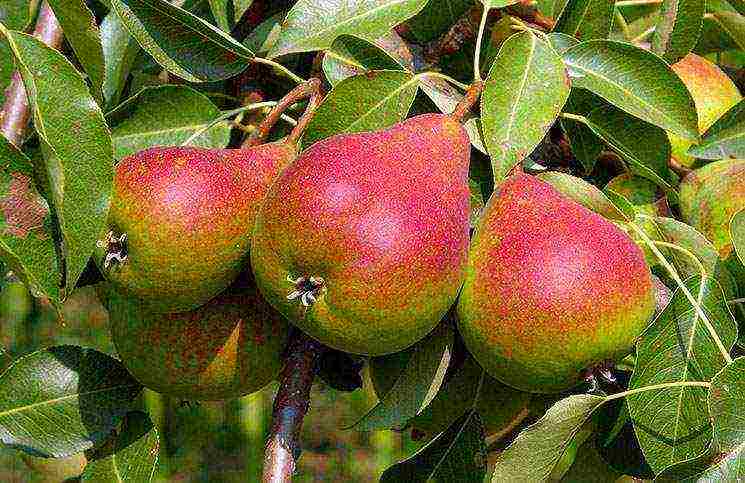
The pear is demanding on soil fertility, illumination, warmth and care. For her, choose a sunny place with fertile soil. If the soil on the site is poor, specially prepared soil is used to fill the large planting pit. The pear will more than thank the gardener for such care. Long-lived pear trees bear fruit for decades.
The best pear varieties for central Russia must meet the following requirements:
- Winter hardiness. For many years, due to its weak winter hardiness, the pear was considered a minor crop in central Russia compared to the apple tree. Modern pear varieties are even more hardy than some apple varieties.
- Taste properties. By choosing sweet and tender varieties, you can grow in the middle lane the same delicious fruits as in the south.
- Productivity. Depends heavily on planting and grooming.
- Early maturity. Most varieties begin to bear fruit in 3-5 years of life, some have to wait even 8 years.
- Self-pollination. Many pears are incapable of such a process. You should focus on at least a partially self-pollinated variety.
According to the harvest time, all varieties are divided into summer, autumn and winter.
Early (summer) varieties
To get a good harvest in the middle of summer or closer to the beginning of autumn, early varieties of pears are in constant demand. Such fruits have a very rich taste with a sour aftertaste, since they do not have time to fully absorb in a short period of solar activity.
Bashkir summer
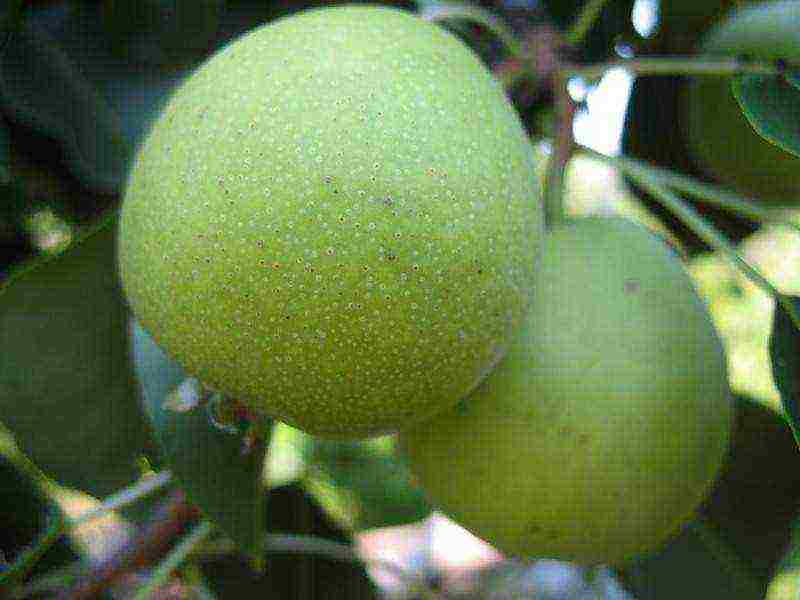
A versatile, winter-hardy, fruitful (45-50 kg per tree), but not fertile variety. A medium-sized tree with a compact, rounded-pyramidal crown of medium density. Greenish-yellow fruits with a slight blush weigh about 100 g. White grainy pulp of medium density with good taste and aroma.
The messenger
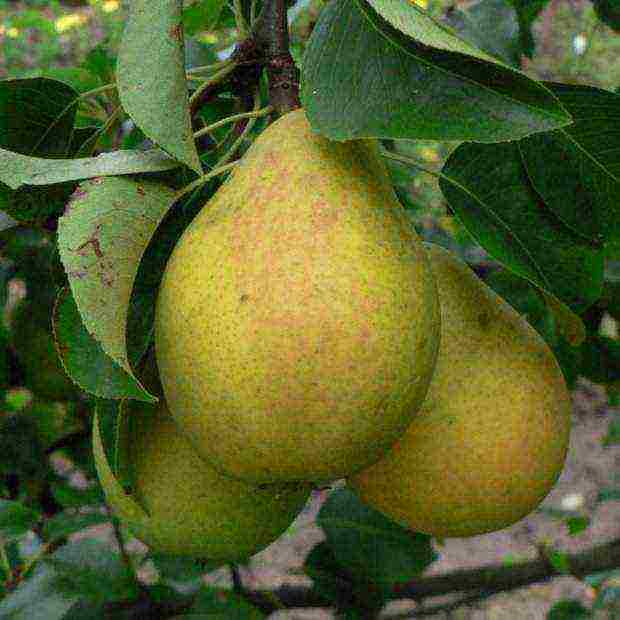
Fast-growing table variety, fruitful, winter-hardy, scab resistant. Medium-sized tree with a sparse back-pyramidal crown. Ribbed-lumpy small (50-60 g) yellow fruits with a slight tan on a long stalk have a sweet taste and light creamy, slightly juicy aromatic pulp of medium density, which liquefies when ripe.
Dessert Rossoshanskaya
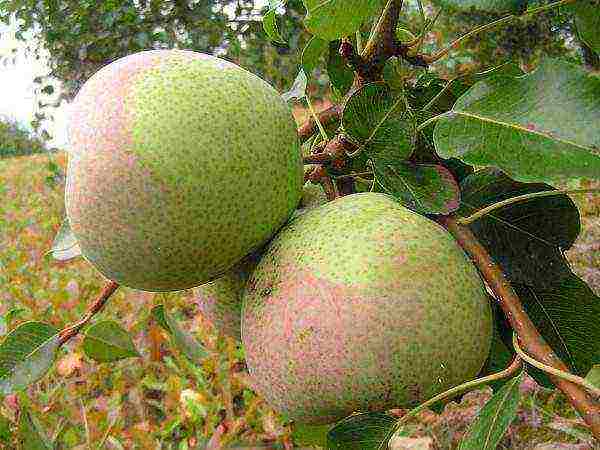
Fast-growing, versatile, fruitful (about 70 kg of fruits from one tree), winter-hardy variety with a sparse, wide-pyramidal crown. Scab resistance is relative. Self-sterile. Large greenish-yellow fruits with a slight blush weigh about 200 g. The saucer and funnel are wide, the stalk is thick and curved. Delicate, juicy, white pulp of medium density has an excellent taste and aroma.
Children
One of the varieties with non-simultaneous, but the earliest ripening period. Winter-hardy, with high frost resistance of the ovaries. A vigorous tree has a compact crown, appreciated by gardeners for its durability. Fruits are bright yellow, with an orange blush, weigh about 80 g. The saucer is small, the funnel is absent, the stalk is short. Very tasty, semi-oily, tender and juicy creamy pulp. The yield from one tree reaches 20-30 kg.
Thumbelina
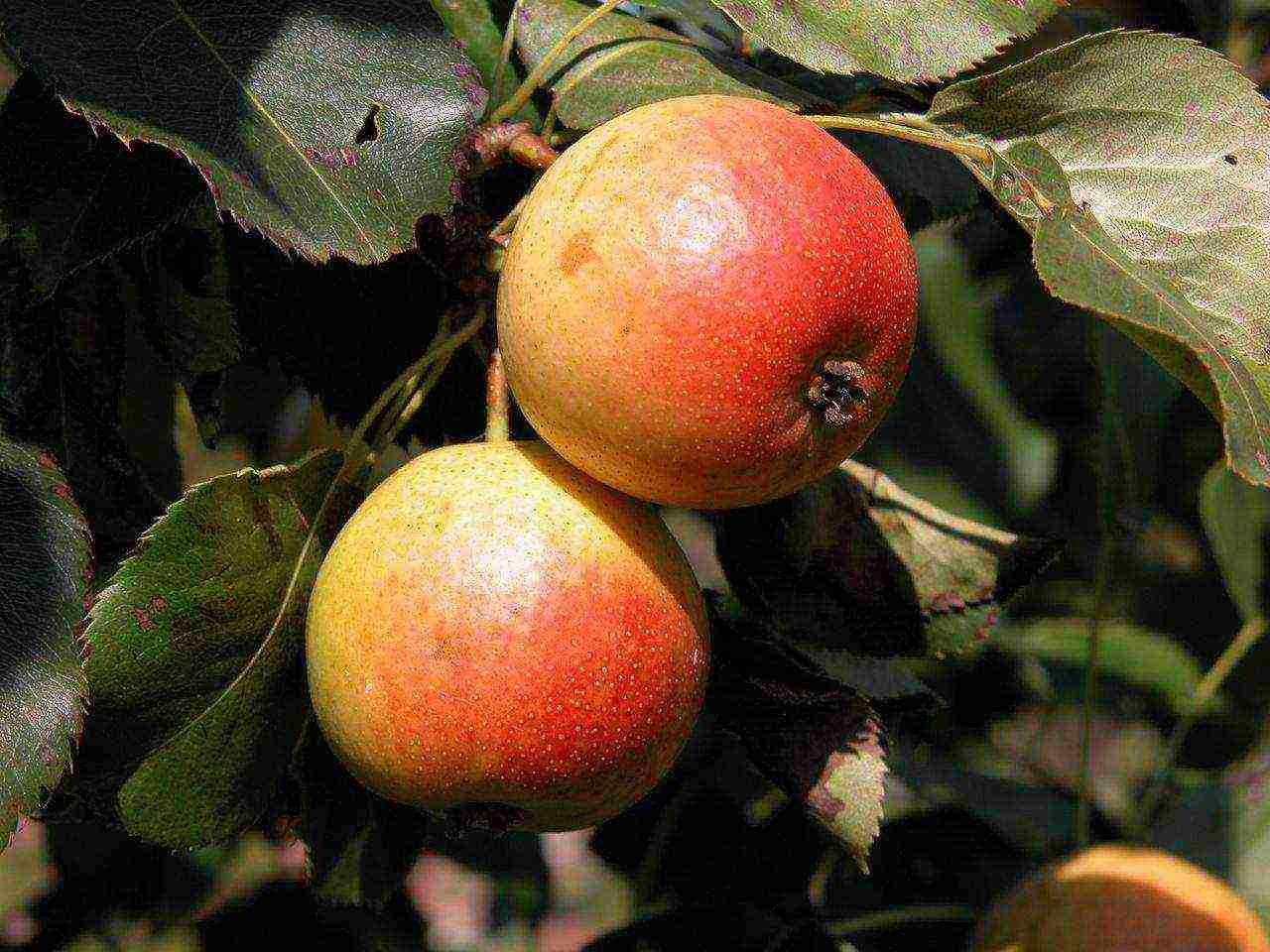
Low-growing (1.5 m), winter-hardy table variety, distinguished by non-simultaneous ripening of fruits and average yield. A medium-sized tree has a dense, rounded crown. Small, brownish-yellow, rusty fruits weighing 60-70 g without funnel, with tender, creamy, very juicy and sweet pulp. The yield reaches 45-50 kg per tree.
Isolde
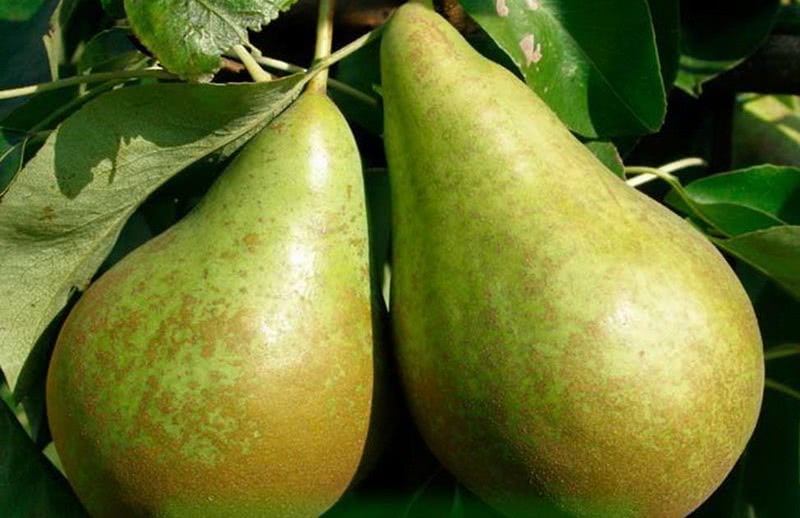
A productive early variety of German selection, resistant to frost and pear scab. A tree with a wide crown grows moderately quickly, ovaries form on the shoots. Bears fruit in the 3rd year. It is characterized by a regular abundance of juicy, medium and large (from 160 to 230 g) fruits with an attractive appearance and a bright red blush.
Cathedral
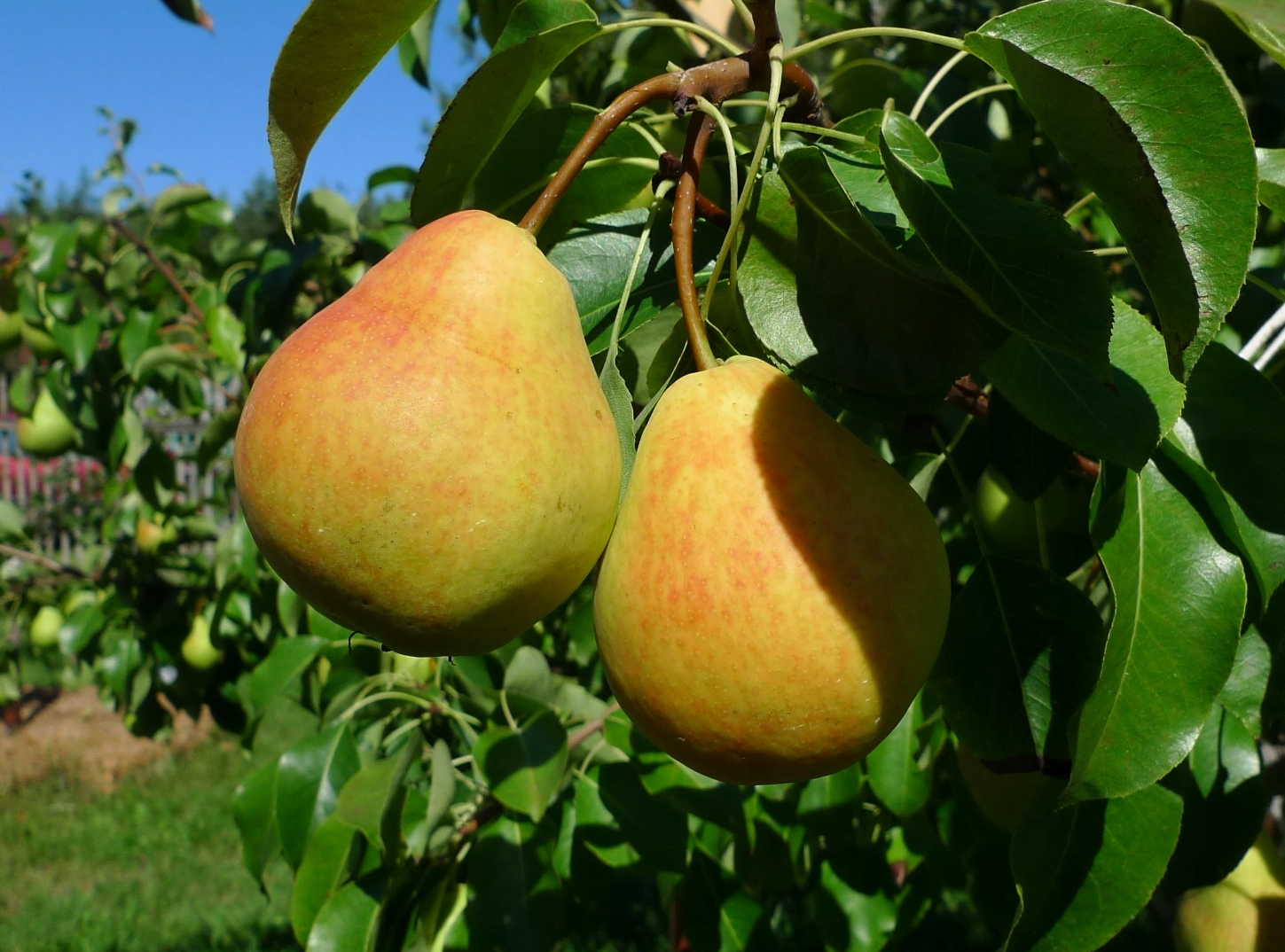
Scab-resistant, versatile, early-growing, winter-hardy variety. A medium-sized tree has a dense, rounded crown. Average yield - 35 kg per tree. Fruits, bright yellow with a red blush, without a funnel, with a shallow saucer and a thick beveled stalk, weigh about 120 g. The semi-oily, juicy, dense pulp has a wonderful taste and aroma.
Space
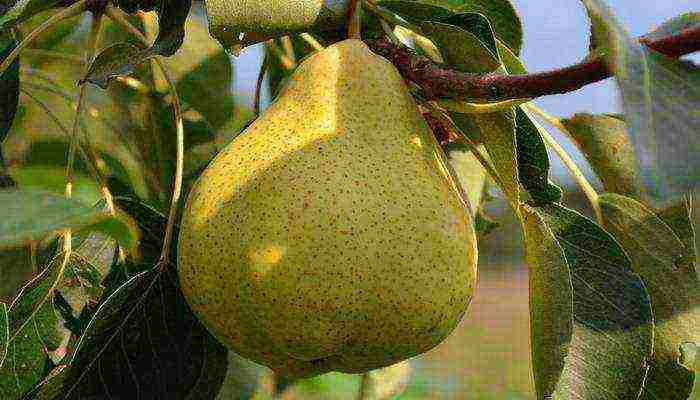
Low-fruiting table variety with high yield (up to 150 kg per tree in some years), medium winter hardiness, relatively resistant to scab. Fruits, greenish-yellow with a slight blush, without a funnel, with a wide saucer. Fine-grained, sweet, juicy white flesh.
Marble
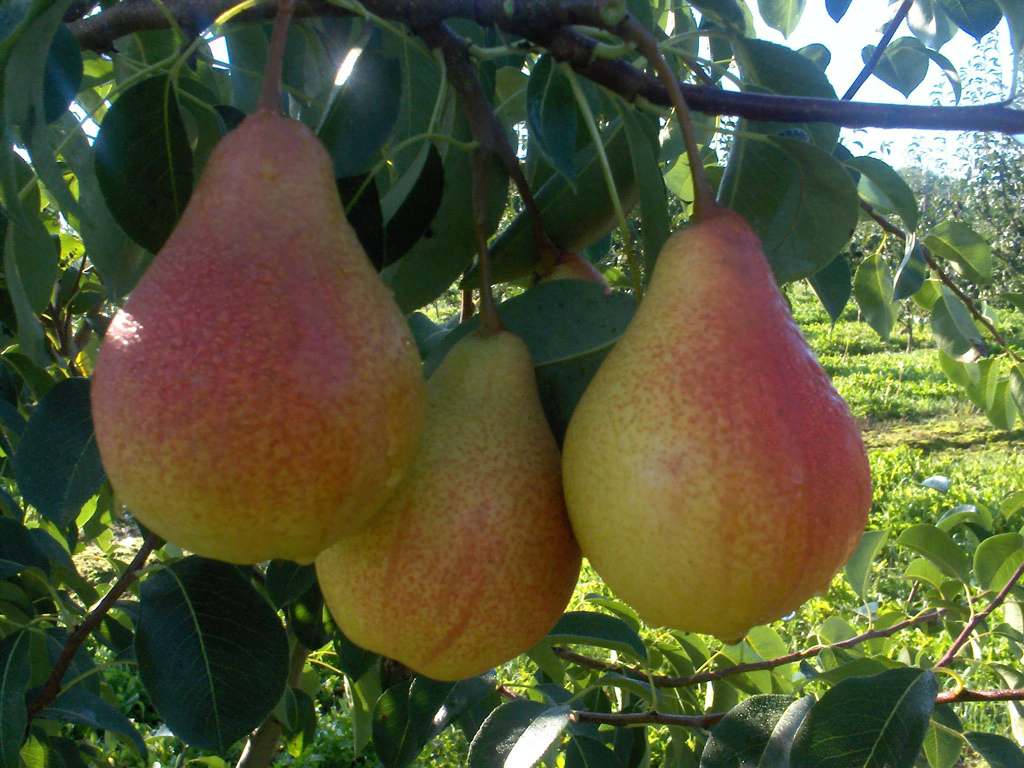
Yielding (about 90 kg per tree) and winter-hardy dessert variety. Relatively resistant to scab, early-growing. A medium-sized tree has a broad-pyramidal crown of medium density. Green-yellow fruits with a blurred blush or streaks and rusty subcutaneous dots weigh about 150 g. The saucer is small, the funnel is narrow, the stalk is inflated. Melting, juicy, coarse-grained, tender, juicy, creamy pulp has an excellent taste.
Oryol summer
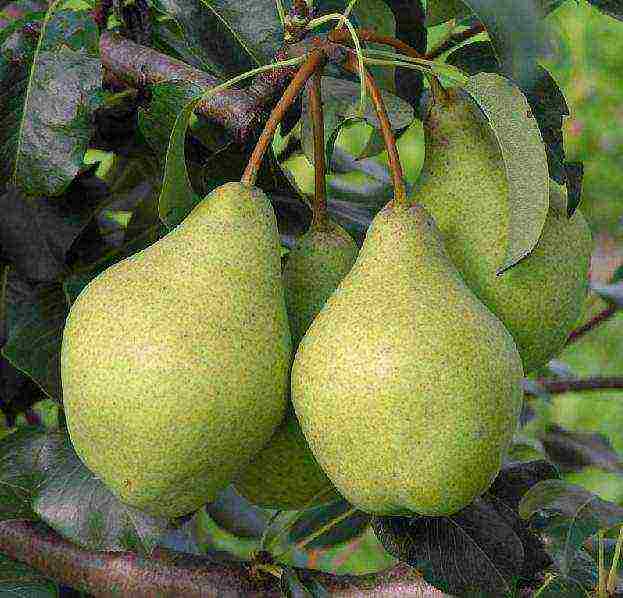
Yielding (35-40 kg per tree per season), early-growing, versatile variety with annual fruiting. Average winter hardiness, relatively resistant to scab. The tree is tall, with a broad-pyramidal crown of medium density. Large (250 g) greenish-yellow fruits with a shallow saucer, without a funnel, have a thick long stalk. Delicious, juicy, dense, semi-oily white pulp with a weak aroma.
Early July
A favorite pear variety for gardeners, which gives a stable yield (on average 60-65 kg per tree) every year.Fruits of the same size (weight 100-120 g) have a regular pear-shaped shape and a pronounced taste with a predominance of sweetness. Elastic flesh practically does not darken in the open air. The variety is suitable for juicing and fresh consumption. Not recommended for preservation because of the rapid loss of flavor saturation.
Rogneda
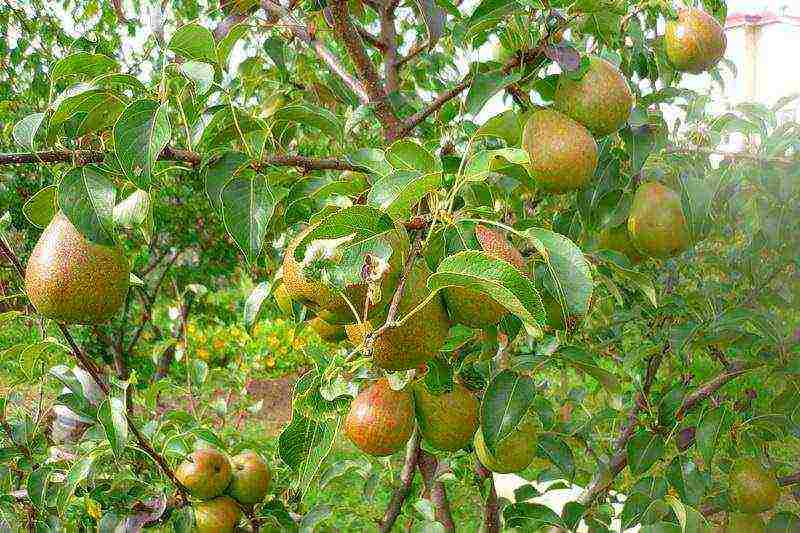
High-yielding (about 90 kg per tree), fast-growing, versatile variety with annual fruiting. It is resistant to scab. Medium-sized tree with a dense, compact, wide-pyramidal crown. Yellow, with a bright red blush, fruits with a deep funnel and a wide shallow saucer have a short peduncle. Fine-grained, juicy, dense pulp with sweet and sour taste and rich aroma. The fruit is characterized by an almost complete absence of acid.
Early ripening
Annually fruiting, disease and frost resistant variety. The tree is tall, fast-growing, with a pyramidal crown, begins to bear fruit in the 5th year. Fruits are uniform in size, small, with thin skin. Due to its soft and juicy pulp, without astringency, it is mainly used fresh and for making juices. Prone to defeat by moniliasis.
Autumn varieties
Autumn pears ripen in mid-September. They must be removed from the trees slightly unripe, avoiding falling off. After a few days of storage in a cool, dark place, they will be ready to eat.
Academic 4-112
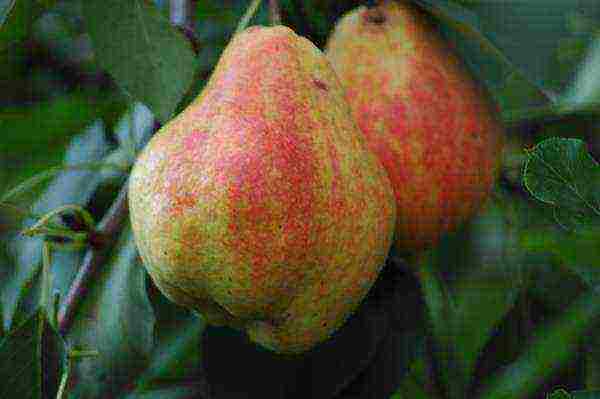
A universal variety with an average (50 kg per tree) yield and winter hardiness, it is resistant to scab. The dense compact crown has a wide pyramidal shape. The fruits are lumpy, pear-shaped, weighing from 130 to 150 g. The skin has a yellow main and dark-burgundy integumentary color. The saucer is ribbed, wide, the funnel is narrow and shallow. The thick peduncle is of medium length. Semi-oily, white, dense, juicy pulp tastes sweet and sour, with a weak aroma.
Bashkir autumn
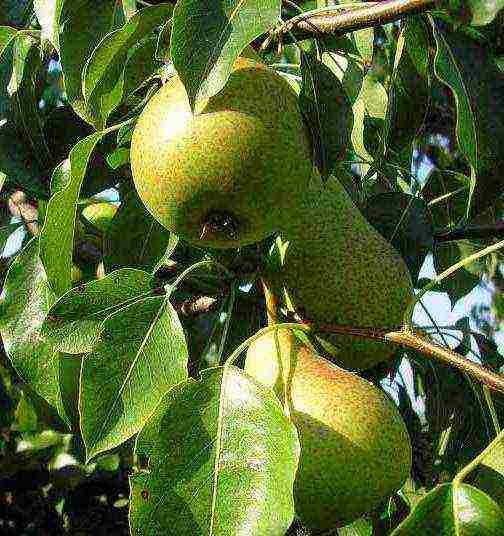
Early autumn high-yielding (70-80 kg per tree) table variety, relatively resistant to scab, winter-hardy. The fruits are elongated pear-shaped with a thick curved peduncle, a wide saucer and a funnel weigh about 75 g. The yellowish-green skin is covered with a blurred red blush on most of the fruit. Juicy fine-grained pulp of medium density has a creamy hue, medium aroma and sweet and sour taste.
Bergamot Moscow
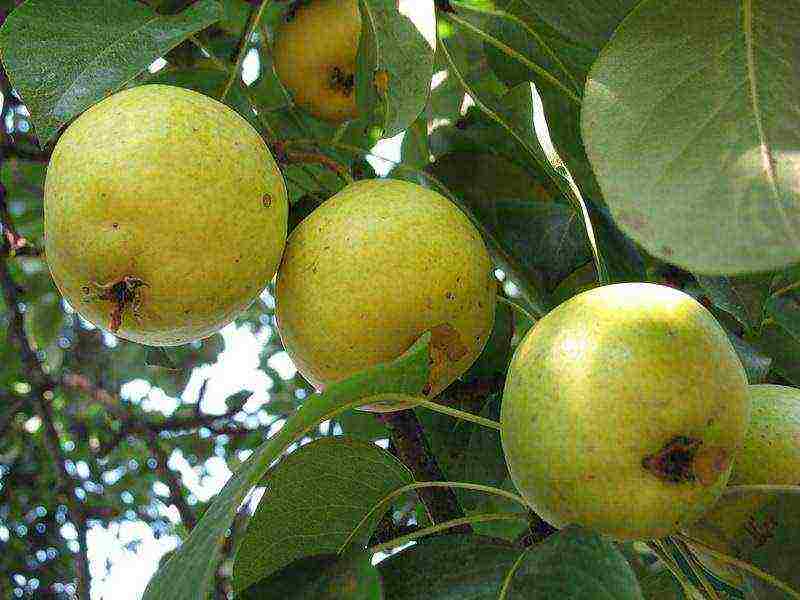
A versatile variety with an above average winter hardiness and an average yield (20 kg per tree), it is resistant to scab. The crown of the tree is sparse, broadly oval. Rounded smooth fruits weighing 150-160 g with a yellowish-green skin have a weak pinkish integumentary color and well-visible large subcutaneous dots. The peduncle is thick, short, straight. The saucer is ribbed, wide. The funnel is of medium width, deep. Juicy, dense, aromatic pulp has a good, sour-sweet taste.
Bere Moskovskaya

Dessert variety with an average yield and high winter hardiness, it is resistant to scab. Weakly ribbed, elongated-conical fruits weighing up to 110 g are covered with a yellow skin with a slightly reddish integumentary color, on which small brown subcutaneous dots are clearly visible. Very juicy, dense, semi-oily pulp has a delicate aroma and dessert taste. In terms of juiciness and softness, the fruits are unmatched, but in hot, dry weather, the quality of the fruits deteriorates.
Veles
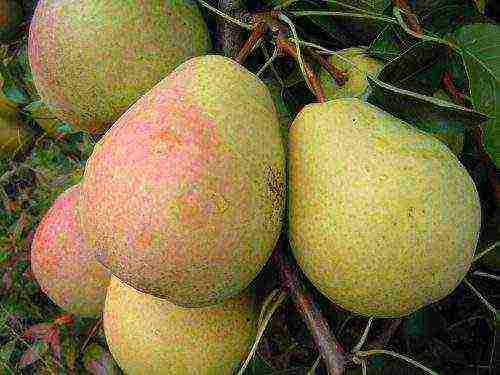
Disease resistant winter-hardy variety with high yields (from 50 to 100 kg per well-groomed adult tree), frost-resistant ovaries. Fruits weighing 120-150 g with a wide funnel and a small, smooth, wide saucer are covered with a yellowish-green skin with a slight orange tan and subcutaneous dots. Delicious creamy pulp is very tender, juicy, semi-oily.
Faithful
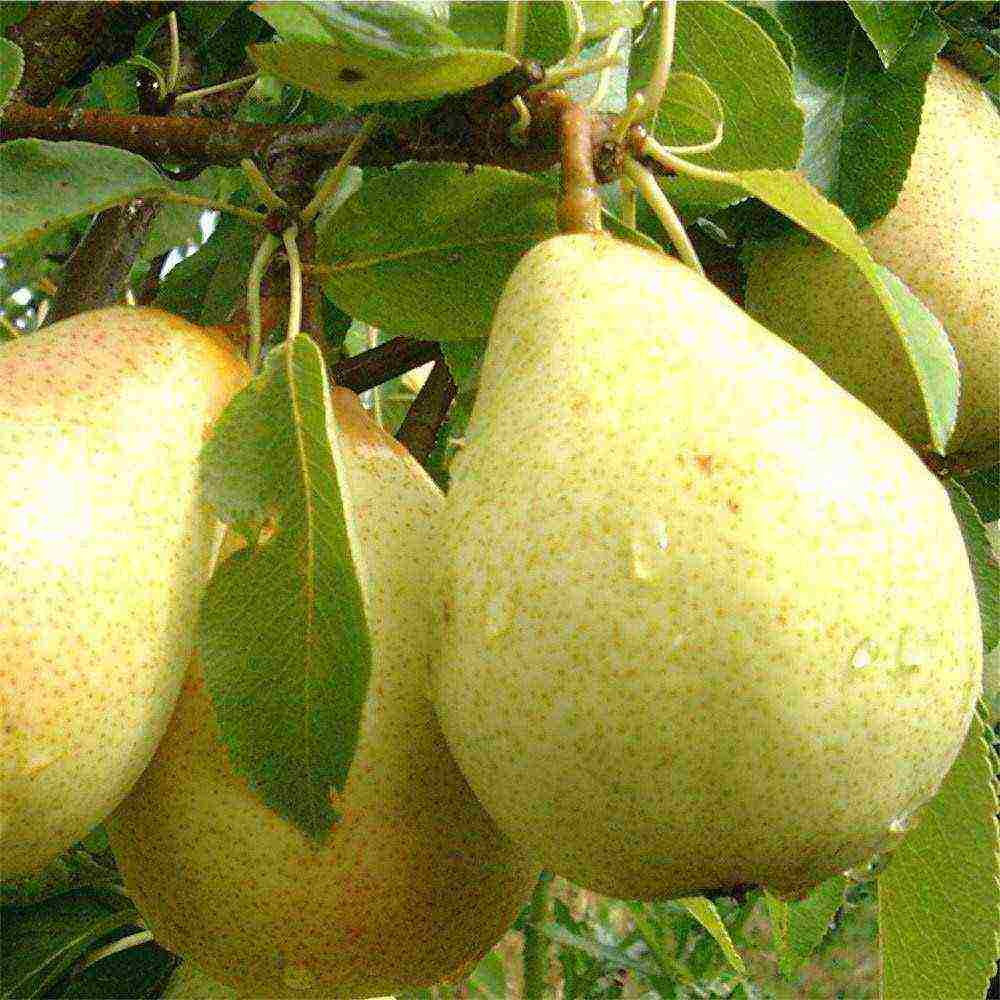
A high-yielding (about 100 kg per adult tree) late autumn variety with high winter hardiness (the ovaries can withstand frosts down to -2 ° C).Symmetrical, without a funnel, fruits with a lightly tanned yellowish skin and a short peduncle weigh from 90 to 130 g. The pulp is juicy, creamy, semi-oily, tasty.
Yeseninskaya
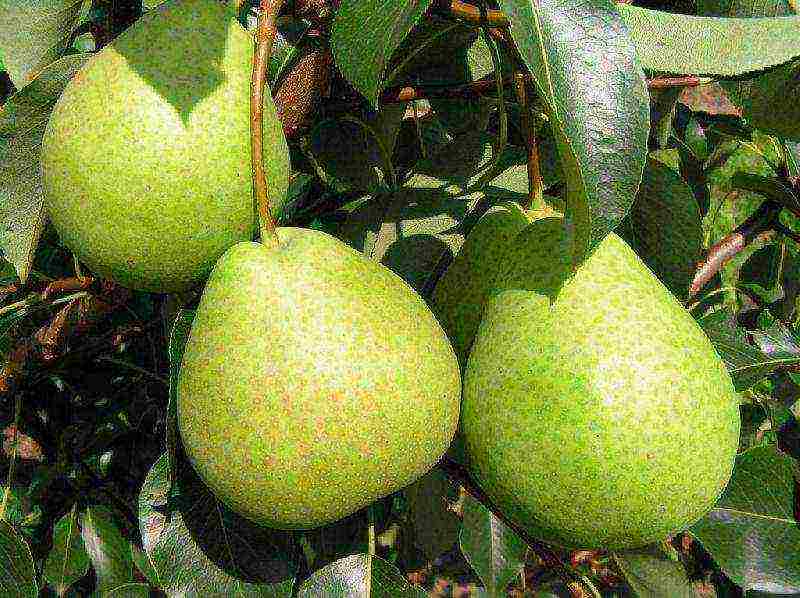
An early autumn high-yielding variety (50 kg per tree), scab resistant. Smooth fruits weighing about 140 g with a very shallow funnel and a wide shallow saucer are covered with a yellowish skin with an orange blush and clearly visible red subcutaneous dots. Semi-oily creamy pulp of medium density, sweet and sour taste, with a slight nutmeg aroma. Differs in high taste of fruits.
Beauty Chernenko
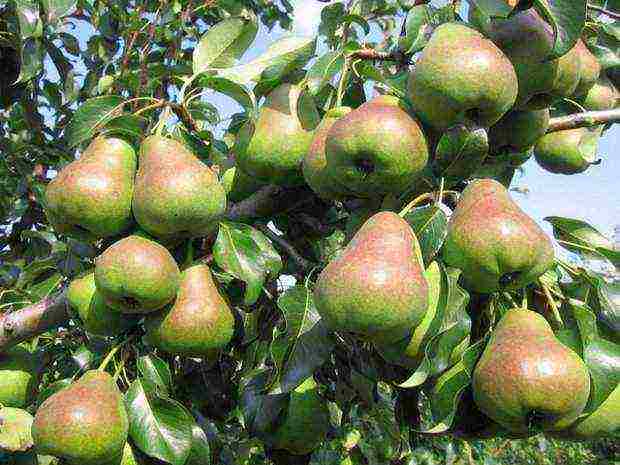
Table variety with high yield (80-85 kg per tree) and average winter hardiness. It is resistant to scab. A tree with a rare narrow-pyramidal crown. Large fruits on a long, thick stalk weighing up to 200 g of golden yellow color are covered with a red blush. The saucer is wide, shallow, the funnel is shallow. Juicy tasty pulp melts in your mouth.
Muscovite
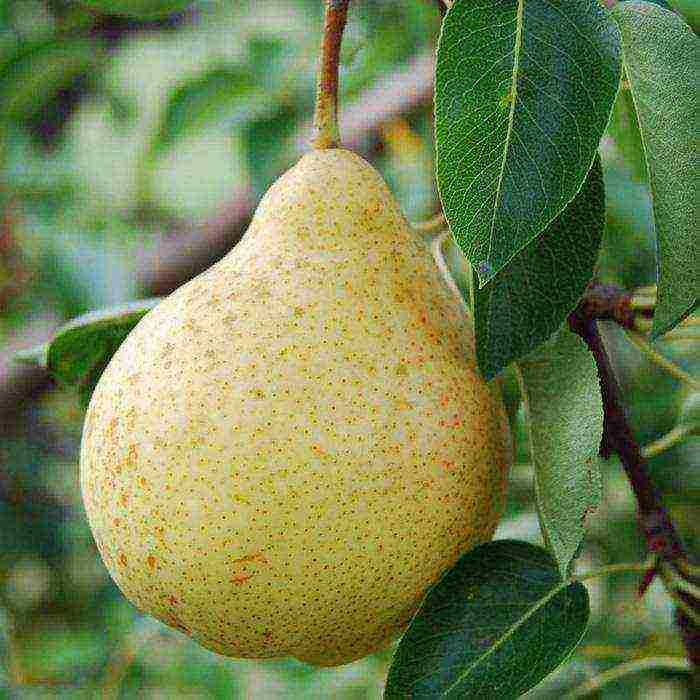
A fast-growing, versatile variety with a high (35-40 kg per tree) yield, resistant to fruit rot and scab. Possesses average winter hardiness. It does not suffer from spring frosts due to late flowering. The tree has a dense conical crown. Sized fruits with a greenish-yellow color with integumentary points and a slight blush, without a funnel, with a wide saucer. Dense, white, semi-oily, very juicy pulp with a strong aroma and excellent taste. Differs in amicable ripening of fruits.
Muratovskaya
Yielding (60-70 kg per tree) table winter-hardy variety, resistant to scab. The green-yellow, blush-coated fruits on a thick, short stalk have a juicy, dense, semi-oily pulp with a sweet and sour taste and faint aroma. The saucer is narrow, there is no funnel.
Elegant Efimova

A table variety with medium winter hardiness and scab resistance. Productivity - 40 kg from an adult tree. The tree has a pyramidal crown of medium density. Yellow-green, unusually beautiful, covered with a bright red blush, fruits weighing about 120 g without a funnel, with a shallow saucer on a long stalk with an influx. Slightly tart, tender, juicy, creamy pulp, very pleasant to the taste.
Otradnenskaya
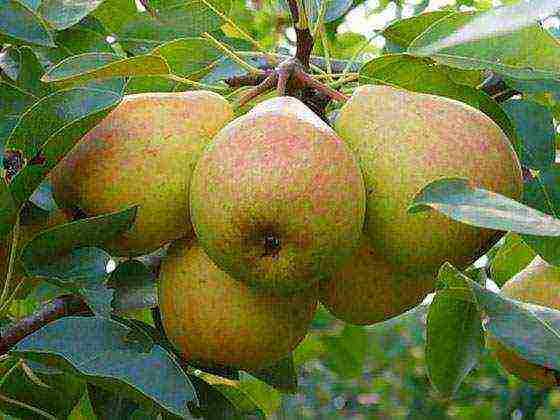
A fast-growing universal variety, medium-yielding (30-40 kg of fruits per tree), winter-hardy. Medium-sized tree with a round-pyramidal, dense crown. Yellowish-green, with a bright blush, fruits weighing about 100 g with a narrow funnel and saucer and a long thin stalk. The pulp is juicy, dense, sweet and sour taste.
Memory of Zhegalov
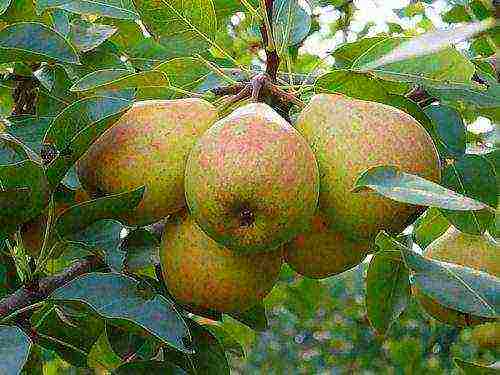
A versatile, early-growing, winter-hardy variety with an average yield (40 kg per tree), scab resistant. The crown is medium-dense, broadly pyramidal. The greenish-yellow fruits with rusty subcutaneous punctures weigh about 120 g. The saucer is ribbed, wide, the funnel is narrow. Semi-oily, dense, juicy pulp, aromatic, with a sweet and sour taste.
Potapovskaya
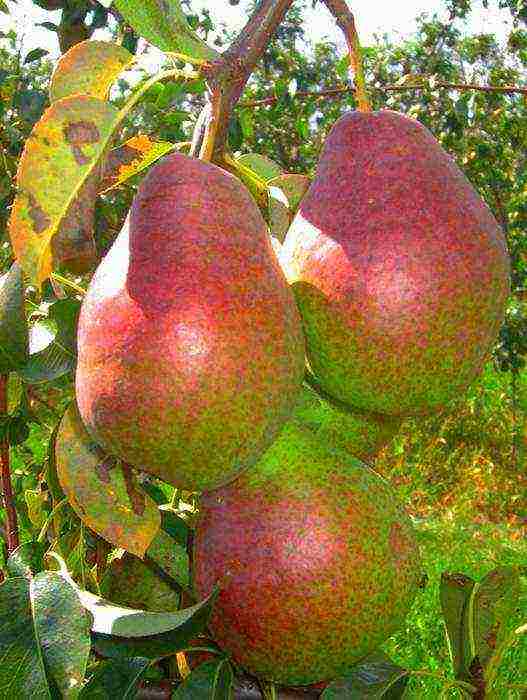
A winter-hardy universal variety with a dense pyramidal crown, scab resistant. Fruit weight about 140 g, yellow skin with red blush. The saucer is small, there is no funnel, the stalk is medium in length and thickness. The pulp is slightly tart, juicy, dense, sweet and sour. Productivity - 55 kg per season from an adult tree.
Fabulous
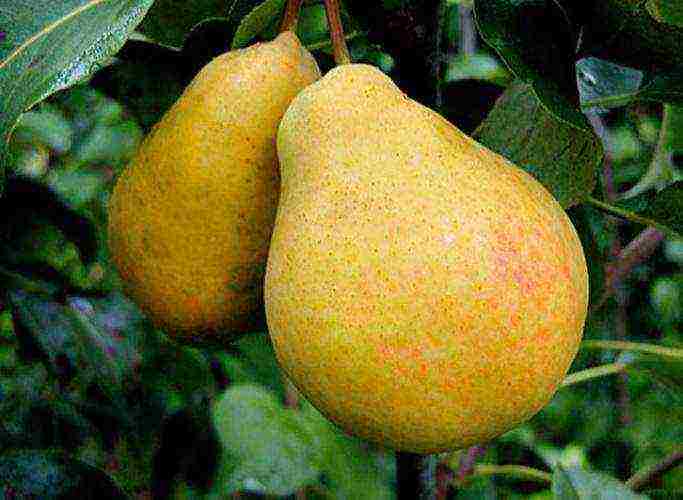
Not fast-growing, drought-resistant, versatile winter-hardy variety, resistant to scab and mites. Productivity - about 10 kg of fruit from one tree. A medium-sized tree with a compact, narrow-pyramidal, slightly spreading crown is heavily overgrown with shoots. The yellow-green fruits with a slight blush are covered with many subcutaneous dots. Medium-dense, fine-grained, tender, juicy white pulp with a very pleasant sweet and sour taste with spicy notes. The fruits are highly preserved, they tolerate transportation well.
Chizhovskaya
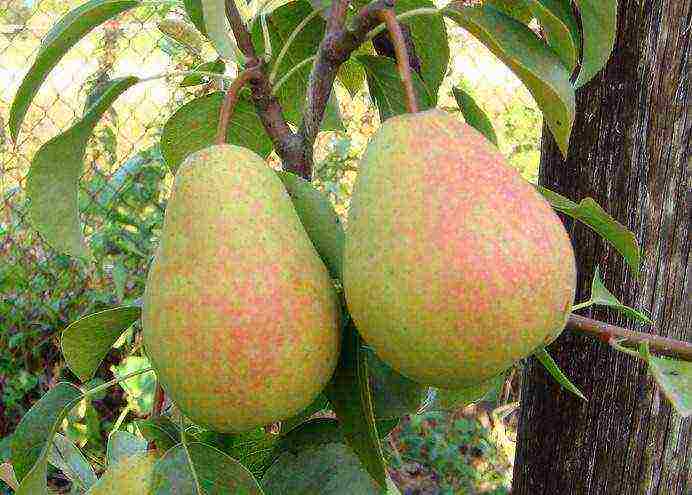
A universal, early-growing (in the 3rd year after planting the seedling begins to bear fruit) variety with an annual yield of up to 50 kg per tree, high winter hardiness, scab resistant. The oval crown is of medium density. Fruits with a yellow-green color, faint blush and subcutaneous punctures weigh about 120 g. The saucer is small, the funnel is narrow, the stalk is short. The pulp is semi-oily, juicy, dense, with a pleasant sweet and sour taste.
Winter (late) varieties
Fruits of late varieties cannot be brought into a warm room immediately after harvesting: they will harden or quickly begin to deteriorate.
Belarusian late

Lying, versatile, fast-growing, high-yielding variety (55-60 kg per tree) with increased winter hardiness. It is resistant to bacterial diseases, but it is affected by scab. A medium-sized tree has a dense crown. Fruits weighing 110-120 g are covered with a thick yellowish skin with rusty subcutaneous punctures, sometimes with a slight blush. Juicy, medium density, yellowish flesh with medium aroma and good taste. It can be stored in the basement until spring (longer than all varieties) (temperature from -1 ° C to 3 ° C, humidity about 80%).
Age-old
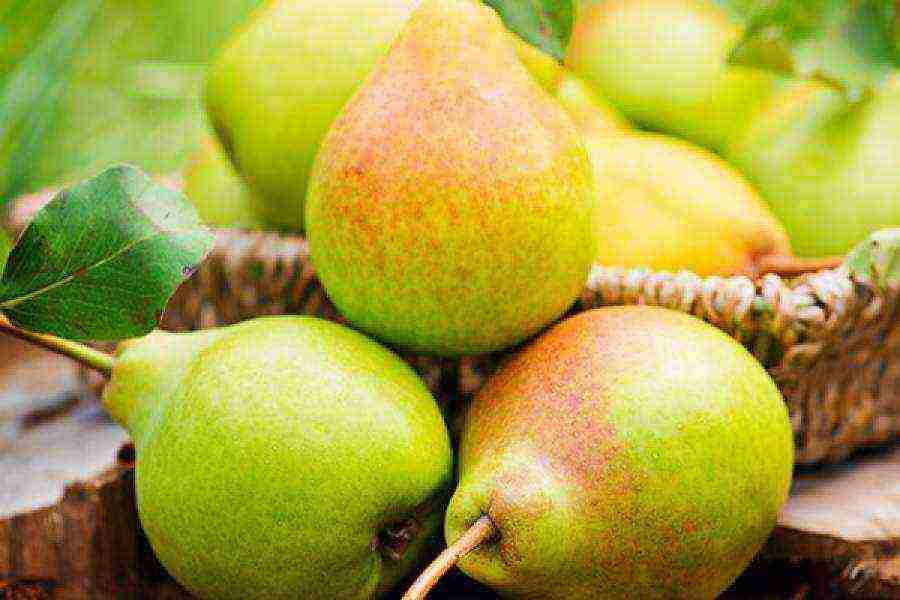
It is frost-resistant, not susceptible to fungal diseases. The tree gives its first harvest 5-6 years after planting. Fruit is harvested at the turn of September and October. Juicy and tasty fruits weighing 130-180 g with a light sourness palpable on the taste are stored for a month. The yield of one tree per season can reach 150 kg.
Festive
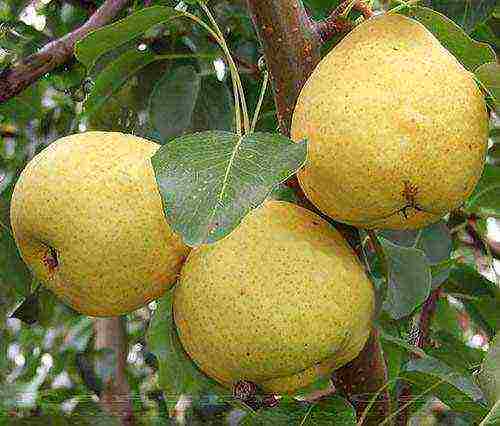
Pest-resistant winter variety with high yields (30-35 kg per tree) and pyramidal crown. Small (up to 100 g) fruits with firm juicy pulp, sweet and sour taste and aroma of tropical fruits have an average keeping quality.
Miracle woman
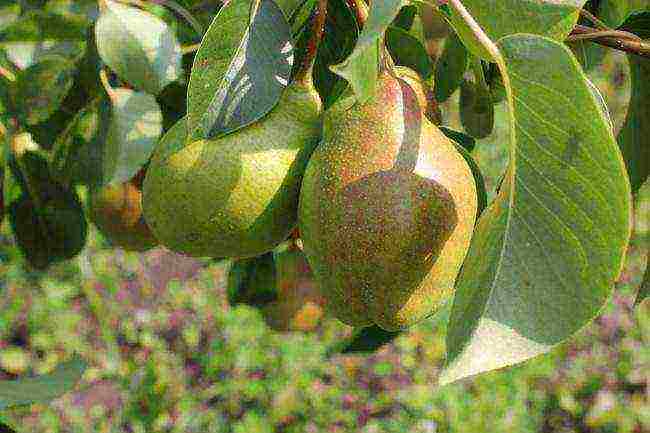
A winter-hardy variety, with high-quality insulation, withstands frosts down to -50 ° C, with a consistently high annual yield. Large (200-220 g) fruits with a pronounced aroma, sweet taste and sourish aftertaste tend to fall off as they ripen.
January

Dessert, fruitful, stable, self-fertile variety, scab resistant. Drought resistance and winter hardiness are average. Medium-sized tree with a rounded crown of medium density. Golden-yellow fruits without a funnel, with a medium-sized saucer, weighing 120-200 g with small subcutaneous punctures. Oily, white, medium-dense pulp with excellent taste and low aroma.
The sweetest varieties
Most ripe pears have a sweet taste, but there are varieties that will be just as sweet, even unripe.
Prominent
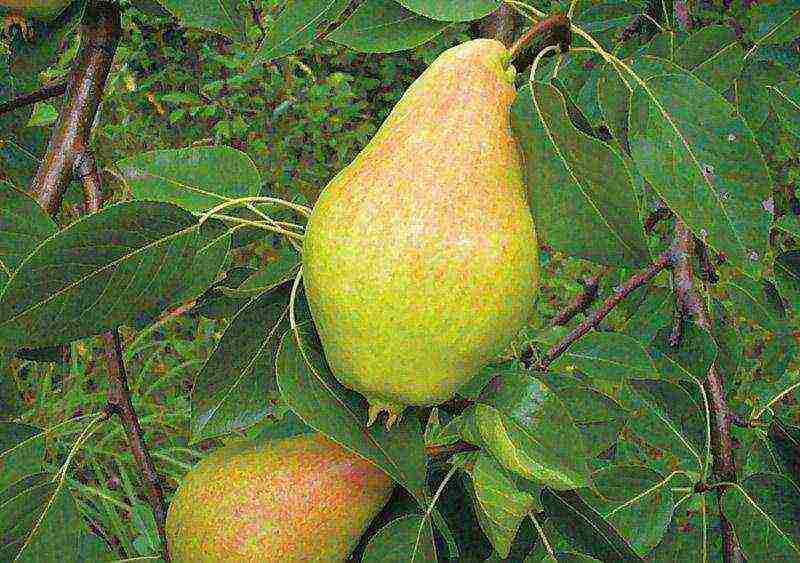
The variety is fruitful, fast-growing, versatile, winter-hardy, scab resistant. The ovaries are characterized by high frost resistance. The tree is vigorous, the crown is narrow-pyramidal. Fruits, greenish-yellow with a slight tan, weighing about 150 g, have a wide saucer, a narrow and shallow funnel, and a thick short stalk. Semi-oily, juicy, tender white pulp with a good sweet taste.
The fruit is not stored even for several days, it is recommended to preserve it or immediately use it fresh.
Buttery sweet
A versatile variety in use, suitable for long-term storage, unpretentious care, disease resistant. Pears with a high concentration of sugar are not only consumed fresh, but they are also made into liqueurs, wine, and canned goods.
Autumn sweet
In terms of juiciness and richness of taste, it is not inferior to southern varieties, resistant to pests and insects, tolerates long-term frosts well. Fragrant fruits of bright yellow color with elastic, juicy pulp are stored for no more than a month.


